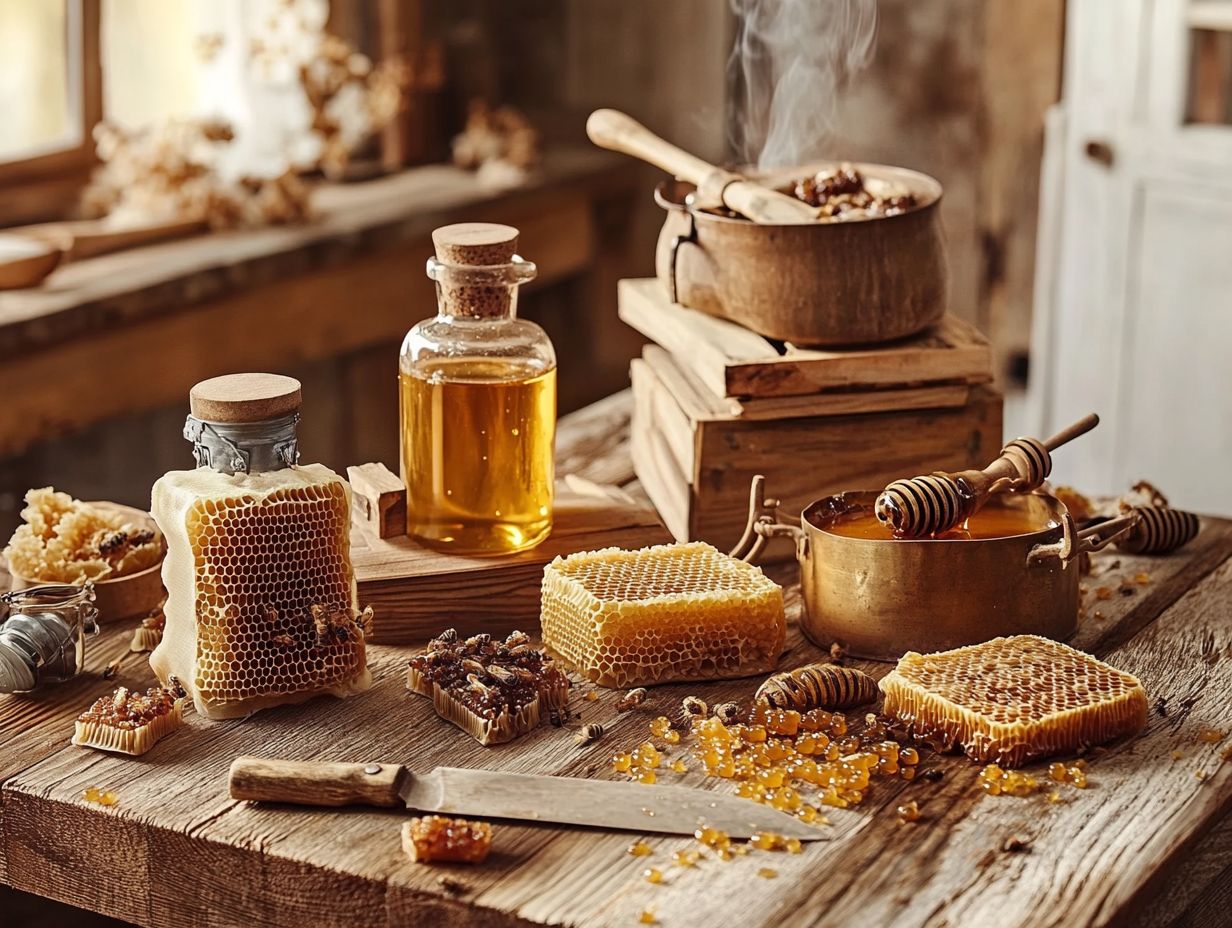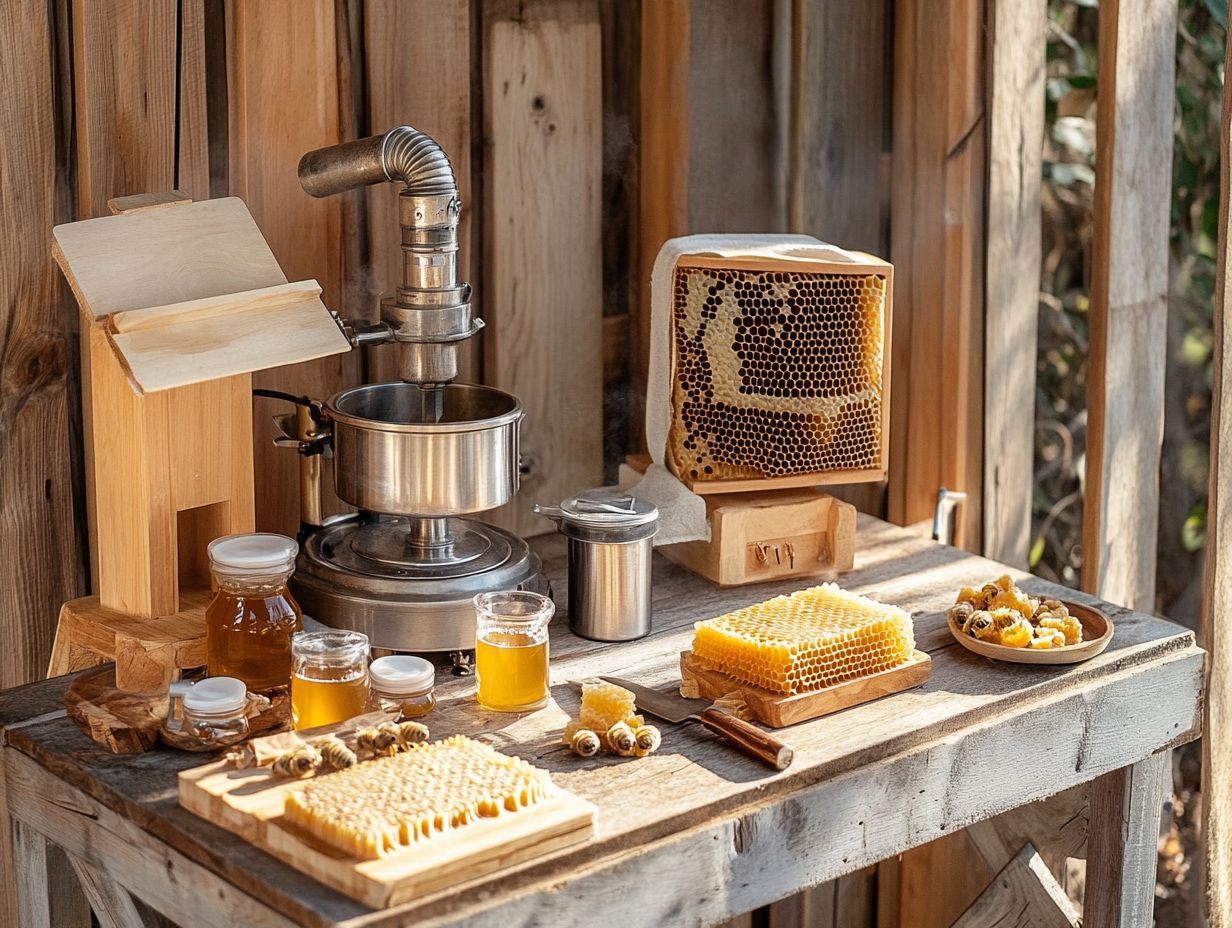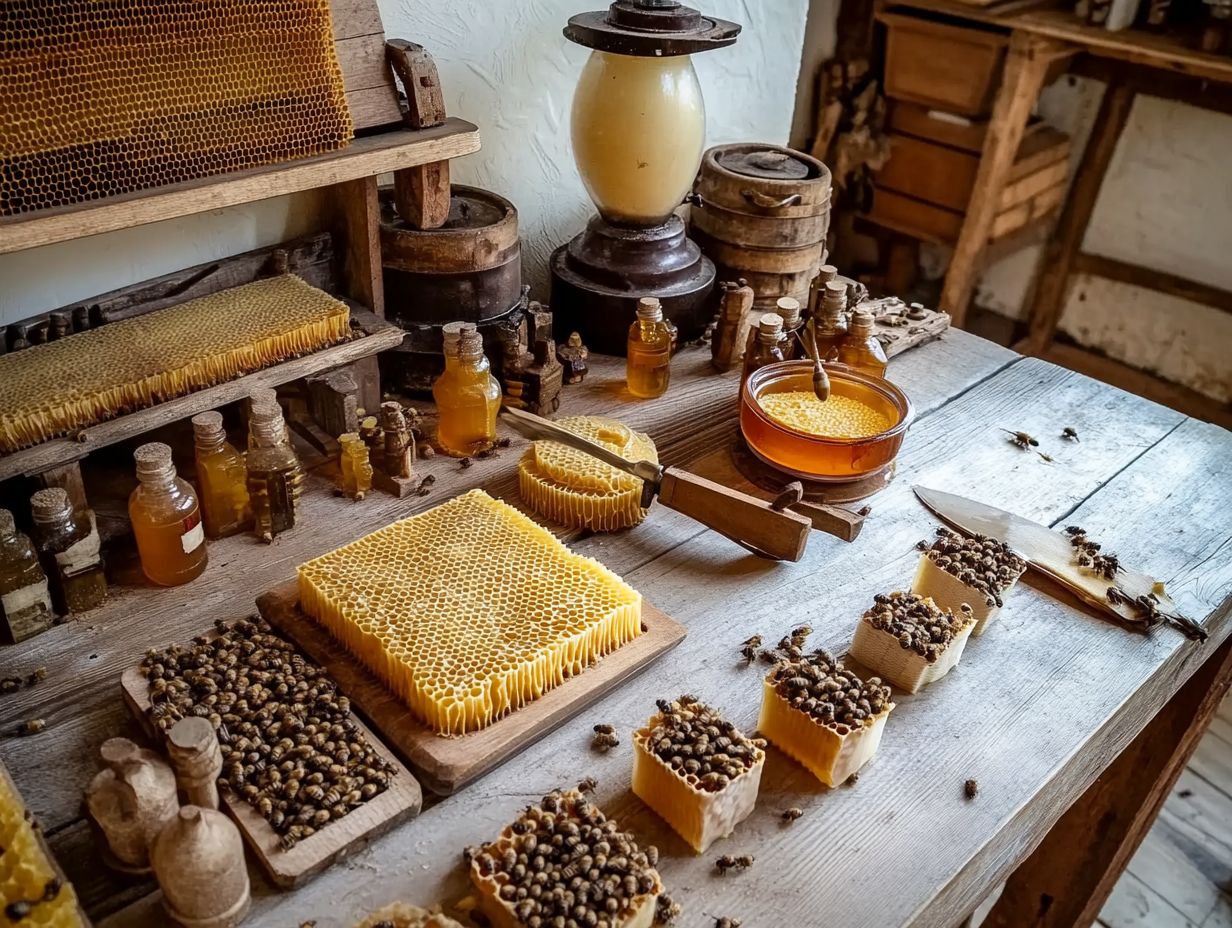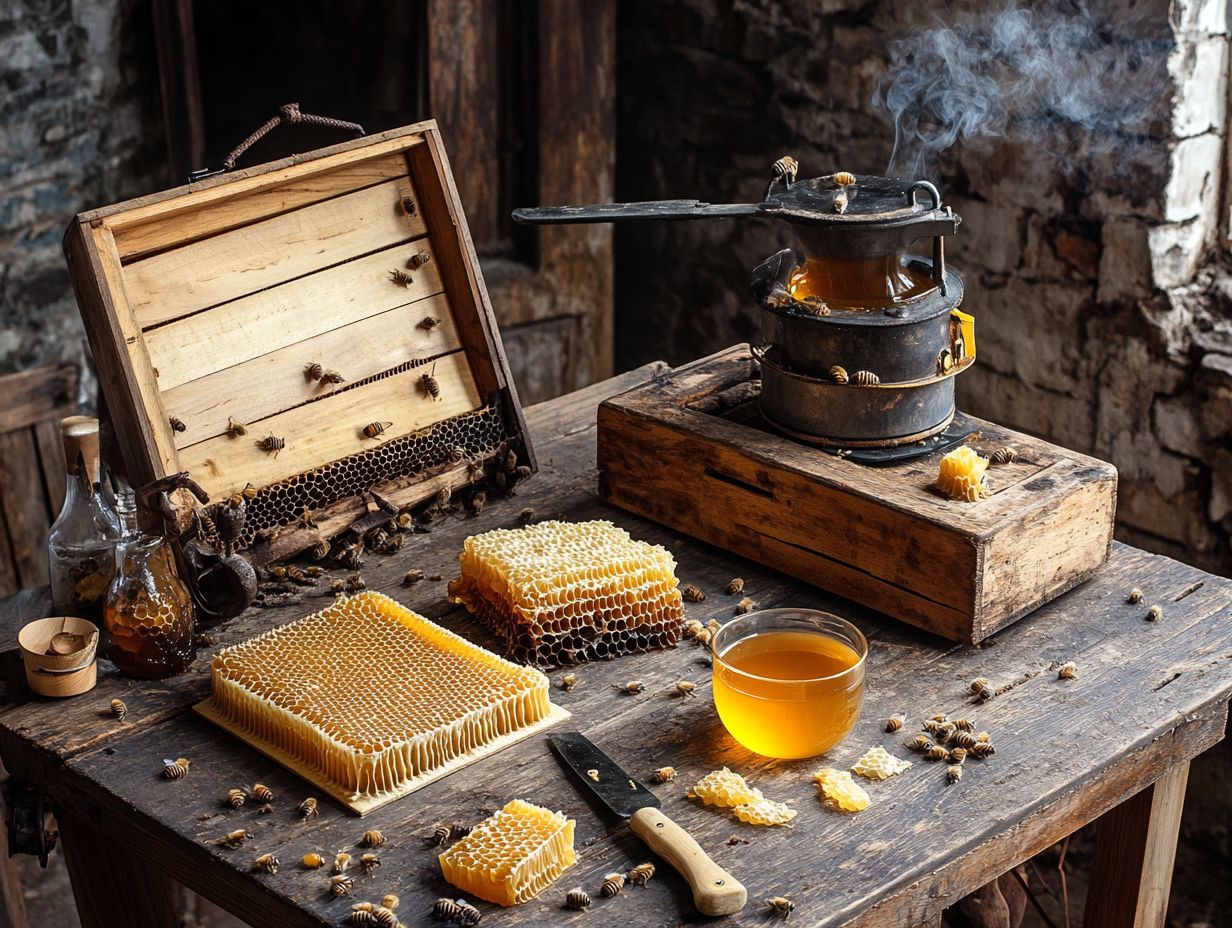Essential Tools for Honey Harvesting
Harvesting honey is truly a rewarding endeavor, but having the right tools and beekeeping essentials is crucial for your success.
Whether you’re a seasoned beekeeper or just starting out, understanding the necessary equipment can significantly impact your honey collection. From protective attire to specialized instruments, every tool plays a vital role in ensuring a smooth and efficient harvest.
This guide outlines the essential tools you’ll need for honey harvesting and provides practical tips on how to use them effectively, allowing you to savor the sweetest rewards of your hard work.
Contents
- Key Takeaways:
- What are the Essential Tools for Honey Harvesting?
- How to Use These Tools for Honey Harvesting?
- Frequently Asked Questions
- What are the essential tools for honey harvesting?
- What is a beekeeper’s suit and why is it important for honey harvesting?
- Why is a smoker an essential tool for honey harvesting?
- What is a hive tool and how is it used in honey harvesting?
- Why is a bee brush necessary for honey harvesting and beekeeping essentials?
- What does a honey extractor do, and how does it help in harvesting?
Key Takeaways:
- Invest in a beekeeping suit to stay safe from stings!
- Use a smoker to calm the bees and make harvesting easier.
- Ensure you have essential tools like a hive tool, bee brush, uncapping knife, honey extractor, strainer, and containers for collecting honey.
What are the Essential Tools for Honey Harvesting?
Honey harvesting requires a specific set of essential tools and equipment that enhance both efficiency and safety during the extraction process. The Basic Honey Harvesting Equipment Kit includes important tools such as a honey extractor, uncapping knife, uncapping fork, a Portable Uncapping Bench, and various storage options like jars and containers.
Every tool, like the honey bottling bucket, plays a vital role in the honey extraction journey. They enable you to gather and process honey with ease and precision, from uncapping the honeycombs to bottling that delicious liquid gold. Familiarizing yourself with these tools is essential whether you’re a novice or an experienced beekeeper aiming to optimize your honey production.
1. Beekeeping Suit
The beekeeping suit, which includes a jacket with a hat veil and gloves, is an essential piece of equipment that protects you from bee stings while tending to your hives, ensuring your safety during honey harvesting activities.
Crafted from materials like cotton and polyester blends, these suits offer a perfect balance of durability and breathability, keeping you comfortable even on warm days. Key design features include a jacket with a hat veil to shield your face and neck while maintaining a clear line of sight. The gloves provide comprehensive protection for your arms and hands against potential stings.
A well-fitted beekeeping suit is not just about safety; it embodies functionality, allowing you to engage confidently with your colonies and promote sustainable practices in bee farming.
2. Smoker
A smoker is an essential tool in your beekeeping arsenal designed to soothe bees before you open a hive and reduce aggression during the honey harvest.
When using this device, you create smoke by igniting various fuels, typically sourced from natural materials like dried leaves, pine needles, or specialized smoker pellets. The smoke disrupts the bees’ communication, making them less inclined to act defensively. This clever tactic enhances your safety and streamlines the honey harvesting process.
The gentle, calming effect of the smoke encourages the bees to focus on consuming honey instead of defending their territory, allowing you to extract honey more efficiently while minimizing disruption or harm to the colony.
Don’t miss out on the perfect harvest! Get your tools ready and enjoy the sweet rewards of beekeeping today!
3. Hive Tool
The hive tool is an essential implement in your beekeeping arsenal. It is expertly designed for prying apart hive boxes, scraping, and manipulating frames during honey harvesting.
Its versatility is unmatched. It plays a critical role in maintaining your hives and ensuring the health of your colonies. Several types of hive tools are available, including the honey gate valve, each tailored for specific tasks.
For instance, the standard hive tool has a flat side for scraping and a curved end for prying, making it a must-have.
Uncapping tools are crucial when extracting honey. They enable you to efficiently remove wax caps from honeycomb cells. Having specialized tools can significantly enhance your honey yield and overall hive health, emphasizing the importance of proper hive maintenance.
4. Bee Brush
A bee brush is an essential tool for beekeepers. It is designed to gently coax bees from frames, especially during honey harvesting, while minimizing disruption to the hive’s delicate ecosystem.
This thoughtfully crafted brush features soft bristles, allowing you to relocate bees with care and precision, safeguarding their well-being. Using the bee brush helps you reduce stress within the colony, preventing aggressive behavior and enhancing their safety.
The design shows a strong focus on functionality and the welfare of the bees, highlighting sustainable practices. By incorporating this tool into your routine, you can protect these invaluable pollinators while securing your honey supply.
5. Uncapping Knife
The uncapping knife efficiently removes wax cappings from honeycombs. This streamlines the honey extraction process and maximizes your yield.
You’ll find various forms of these knives, including electric, heated, and manual options, each designed for different preferences and scales of honey harvesting. Crafted from materials like stainless steel and aluminum, they ensure durability and ease of cleaning—essential for maintaining hygiene throughout your beekeeping practice.
When using an uncapping knife, remember to heat the blade sufficiently to melt the wax cappings effectively. Your technique and choice of tool can significantly influence both the quality and quantity of honey extracted, making it crucial to find the perfect fit for your operation.
6. Honey Extractor
A honey extractor is an essential tool in your honey harvesting toolkit. It is expertly crafted to extract honey from frames without compromising the delicate wax combs.
This amazing tool makes honey harvesting a breeze while safeguarding the integrity of the combs for the bees’ future use. By spinning the frames at impressive speeds, centrifugal force—the force that pushes honey out when the frames are spun quickly—draws honey out while keeping the wax intact.
You’ll find various types of honey extractors available, including manual, electric, and radial models. Each is designed to suit different operational needs and hive sizes. Recognizing the importance of these extractors can significantly enhance your honey harvesting process, allowing you to collect high-quality honey with minimal effort and maximum yield.
7. Strainer
A honey strainer is an essential tool that filters out impurities like bee parts and wax particles from freshly extracted honey. This ensures you end up with a clear and pure product.
You’ll find various types of honey strainers tailored to different needs, made from materials ranging from stainless steel to fine mesh nylon. Stainless steel strainers are popular due to their durability and rust resistance, making them ideal for repeated use in your honey processing routines.
Nylon strainers present a lightweight alternative that effectively captures even the tiniest particles, enhancing the overall quality of your honey. By using high-quality stainless steel honey strainers, you can significantly improve your final product, offering consumers a more refined and delightful experience when savoring your honey.
8. Jars and Containers
After extracting honey, the importance of proper storage cannot be overstated. You’ll want to have jars and containers at the ready—think honey bottling buckets, 5-gallon buckets, and a honey gate (a device that allows honey to flow from a container without spilling)—to keep your honey fresh and uncontaminated.
Selecting the right container is key. It helps preserve the unique flavor and quality of the honey while preventing crystallization and contamination. Consider your options: glass jars, plastic squeeze bottles, and stainless steel tanks, each offering its own set of advantages.
- Glass jars are non-reactive and provide an airtight seal, ensuring your honey stays just as delightful as the day you extracted it.
- Plastic containers are lightweight and incredibly convenient for dispensing.
Choose the right sizes for your needs to enjoy your honey to the fullest, whether you prefer small jars for personal use or larger tanks for bulk storage.
Finally, remember to keep your storage area cool and dark to maximize the honey’s longevity.
9. Labels and Markers
Labels and markers are essential in the honey harvesting process. They offer vital information for labeling jars and containers, including Honey-B-Gone, ensuring everything is properly identified.
Labels identify your jars and also ensure compliance with industry regulations. By including key details such as the honey’s origin, batch number, and expiration dates, they promote transparency and foster trust with consumers. You have a variety of labeling options at your disposal, from adhesive stickers to shrink sleeves. Markers can add a personalized touch for artisanal producers.
The importance of these labeling practices goes beyond mere aesthetics; they play a fundamental role in food safety and traceability, underscoring the significance of responsible production in today’s marketplace.
How to Use These Tools for Honey Harvesting?
Utilizing the right tools with precision is essential for a successful honey harvesting experience. This process involves a series of carefully defined steps designed to maximize efficiency while minimizing any disturbance to the bees.
By thoroughly preparing the hive and employing a smoker to soothe the bees, you set the stage for a smooth operation. Incorporating specialized tools like uncapping knives and honey extractors allows you to transition seamlessly from hive to jar.
Mastering these essential instruments eases the extraction of high-quality honey and fosters sustainable beekeeping practices that honor the bees and their environment.
1. Preparing the Hive
Preparing the hive is your first step in the honey harvesting journey, and it demands careful planning along with the right tools to guarantee a seamless extraction process.
Gather your equipment carefully—don’t underestimate the importance of a smoker, which plays a vital role in calming the bees during your inspection. Once you’re geared up, approach the hive gently and start inspecting the frames for any signs of readiness. Look for capped honey cells; they’re your golden ticket, indicating that the honey is perfectly stored and ready for you to harvest.
Assessing the overall health of the colony is essential. A thriving bee colony enhances the quality of your honey and supports the sustainability of your future harvests.
2. Using the Smoker
The smoker is an essential tool for soothing bees before you delve into hive inspections and honey harvesting, creating a safer atmosphere for your beekeeping endeavors.
By producing cool, dense smoke, this device effectively obscures the bees’ pheromonal communication (the way bees communicate with each other using scents), which diminishes their defensiveness and enables you to work with greater confidence. Properly utilizing a smoker means filling it with natural materials like pine needles, burlap, or cardboard. When ignited, these materials generate the necessary smoke without risking overheating.
Puff the smoke gently to ensure a calm hive—your success depends on it! Make sure it permeates the hive entrance and frames during the harvesting process. This technique not only calms the bees but also minimizes disturbance, leading to a more efficient and safer honey collection while preserving the overall well-being of the colony.
3. Using the Hive Tool
The hive tool is your go-to for prying apart hive boxes and frames. It’s essential for accessing those honey-filled treasures during the harvesting process.
This versatile tool is a true multitasker. It scrapes and removes a sticky substance bees produce that tends to accumulate on surfaces, potentially obstructing your access.
When using a hive tool, maintain a firm grip but be careful not to apply too much force. This could damage the frames or unnecessarily disturb the bees.
Gear up with your protective outfit! It’s your best defense against stings and ensures a safe harvesting adventure. Pairing the hive tool with tools used to remove wax covers from honey during honey extraction streamlines your process, enabling you to harvest efficiently while preserving the integrity of those precious combs.
4. Using the Bee Brush
Using a bee brush is essential for gently removing bees from the frames without causing them harm. This ensures that your honey harvesting experience goes off without a hitch.
This specialized tool features soft bristles designed to delicately dislodge bees from the honeycomb. It’s a must-have in your bee yard during extraction.
By employing the bee brush with a gentle touch and slow, deliberate movements, you significantly reduce agitation among your bee population. This protects the bees and boosts the overall efficiency of your honey gathering process, leading to a more productive harvest.
Mastering techniques like brushing in a downward motion and working in sections creates a stress-free environment for both you and the bees. This enhances the harmony of your beekeeping experience.
5. Uncapping the Honeycomb
Uncapping the honeycomb is a vital step in honey harvesting. You’ll use an uncapping knife to remove the wax cappings from the honey-filled cells gracefully.
This meticulous process ensures that the delicious liquid gold can flow freely during extraction.
Many beekeepers prefer a heated uncapping knife, as it efficiently melts the wax for quick and clean removal. Alternatively, uncapping forks offer a gentler method by puncturing and delicately scraping away the cappings. This is perfect for those wishing to handle the honeycomb with care.
Depending on the scale of your operation and your personal preference, you might choose either tool. Understanding the right uncapping tools can supercharge your honey yield while preserving the integrity of the honeycomb.
6. Extracting the Honey
The honey extraction process requires you to utilize a honey extractor, which efficiently spins the honey out of the uncapped frames.
Honey extractors come in two main types: radial and tangential extractors. Radial extractors spin the frames outward, allowing honey to cascade down the sides, while tangential models rotate the frames on a horizontal axis, extracting honey one side at a time.
Both types are efficient, but you’ll find that radial extractors generally yield honey more quickly due to their design. For beekeepers like you, understanding these distinctions can profoundly influence your honey production efficiency, ultimately determining how swiftly and effectively you can harvest that delightful golden liquid.
7. Straining the Honey
Straining the honey is a crucial step in removing impurities after extraction. Using a stainless steel honey strainer is an excellent way to achieve the clarity you desire.
This process not only elevates the visual appeal of your final product but also extends its shelf life by eliminating sediments and wax particles that may have found their way in during harvesting.
You have various strainer options at your disposal, such as nylon mesh or fine mesh strainers, depending on how refined you want the filtration to be. Follow these easy steps to strain your honey:
- Start by letting the honey settle in a warm location to help separate the impurities.
- Next, pour the honey slowly through your chosen strainer into a clean container, ensuring a smooth flow. Keep an eye out for any clogs that may need clearing to maintain that lovely consistency.
8. Labeling and Storing the Honey
Labeling and storing honey in the right jars and containers is essential for preserving its quality and ensuring you can easily identify it later.
Glass jars are often your best bet because they won’t change the honey’s taste. Opt for dark-colored or opaque containers to protect the honey from light, which can gradually degrade its flavor and nutrients.
Label your jars with the harvest date and type of honey, like wildflower or clover. This not only informs but also builds trust with customers.
Store honey away from sunlight in a cool, dry place. Tightly seal the jars to keep moisture out and extend its shelf life.
Frequently Asked Questions
What are the essential tools for honey harvesting?
The essential tools for honey harvesting include a beekeeper’s suit, a smoker, a hive tool, a bee brush, a honey extractor, and jars for storing honey.
What is a beekeeper’s suit and why is it important for honey harvesting?
A beekeeper’s suit is your shield against bee stings, making harvesting safer and more enjoyable! It usually consists of a full body suit, gloves, and a veil.
Why is a smoker an essential tool for honey harvesting?
A smoker is crucial as it produces smoke that calms the bees, making it easier for you to handle the hives and collect honey.
What is a hive tool and how is it used in honey harvesting?
A hive tool is a handy tool with many functions used by beekeepers to open beehives, scrape off excess wax, and remove frames. It is vital for honey harvesting as it helps to safely and efficiently extract honey from the hives, alongside other uncapping equipment like the uncapping fork and the Portable Uncapping Bench.
Why is a bee brush necessary for honey harvesting and beekeeping essentials?
A bee brush is a soft, gentle brush used to remove bees from frames and boxes without harming them. It is essential for honey harvesting as it allows for the gentle handling of bees, reducing the risk of bee stings.
What does a honey extractor do, and how does it help in harvesting?
A honey extractor is a special piece of equipment used to extract honey from the honeycomb. It works by spinning the frames and using centrifugal force to remove the honey without damaging the comb, allowing for the honey to be collected and stored.




